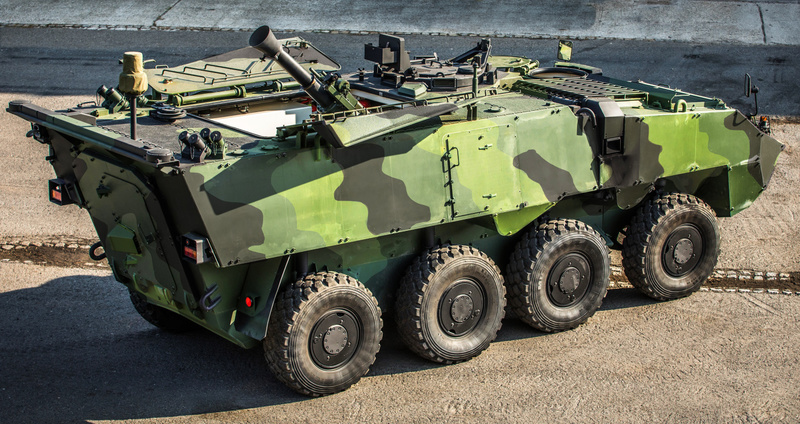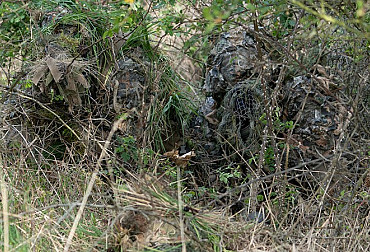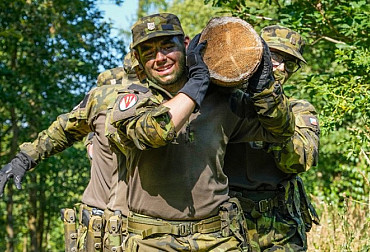Options of New Self-propelled Wheel Mortars for the ACR
I have already dealt with tracked types of mortars in relation to the planned acquisition of self-propelled mortars for the Army of the Czech Republic. In addition to these impressive heavy types, there are also numerous self-propelled mortars mounted on various wheeled chassis. These will be discussed in this article.
The growing popularity of wheeled self-propelled mortars is related to the general popularity of wheeled vehicles as such, which are generally cheaper and less demanding to operate than tracked vehicles. Especially wheeled armoured personnel carriers in the arrangement 8x8 (and the infantry wheeled combat vehicles derived from them) have gradually become a standard part of the modern armies. There are whole large units (regiments, brigades) built on these vehicles. Such units, however, also need adequate fire support, which is usually provided by mortars. Classic drawn mortars are no longer suitable for this purpose - and that is why the idea emerged to place the mortar directly on the chassis of the armoured personnel carrier. Attention is increasingly focused on the powerful 120 mm types, because it turns out that the calibre 81 or 82 mm is not sufficient for the purpose of a self-propelled mortar.
Wheeled self-propelled mortars based on armoured personnel carriers can generally be divided into two categories - systems equipped with a turret and systems that have a mortar mounted in the vehicle’s hull.
One of the first types of wheeled self-propelled mortar with a turret was the Soviet mortar 2S23 NONA-SVK, which combines the chassis of the BTR-80 armoured personnel carrier with a 120 mm mortar 2A80 capable of direct fire. Self-propelled mortar 2S23 proved to be very successful and has undergone considerable expansion in the Russian army, or more precisely in the armies of post-Soviet states. The Chinese self-propelled mortars are very similar as they are built on the basis of various wheeled armoured personnel carriers.

Picture: Soviet mortar 2S23 NONA-SVK, which combines the chassis of the BTR-80 armoured personnel carrier with a 120 mm mortar 2A80 | V. Kuzmin / CC BY-SA
There is a weapon that is more technically advanced and that is the well-known Finnish double-barrelled mortar AMOS, which can be mounted on a wheel chassis due to its high modularity. This self-propelled mortar has already been introduced in the Finnish army. It was added to the well-known AMV armoured personnel carriers, creating a self-propelled mortar XA-361-AMOS. Despite their quality, these mortars have achieved only a small expansion, which is mainly due to their high price.
This is one of the reasons why the simpler (and cheaper) version of the AMOS system was created, the mortar turret NEMO with only one 120 mm barrel. A mortar designed this way has a lower cadence, but on the other hand, it is significantly cheaper. The advantage of this system lies in their lower weight, which allows them to be mounted even on lighter chassis.

Picture: XA-361-AMOS | Wikimedia Commons
A similar self-propelled mortar using a turret is the Polish RAK mortar. It was originally intended to be mounted on tracked chassis, but the Polish army eventually mounted it on their vehicles Rosomak (AMV modification).
The great advantage of these systems is their high modularity, which enables them to be mounted on various chassis. Due to their low weight and modularity, both the RAK system and the NEMO system could certainly be mounted on vehicles operated by the ACR, such as Pandur wheeled transporters. But the question is whether such a solution would be suitable for the ACR.
In general, wheeled self-propelled mortars with a weapon mounted in a turret are very popular and also photogenic. However, their relatively small expansion suggests that their true combat value is somewhat polemical.
First of all, the types designed for direct fire are less suitable for this task as their firing range is in this case very low. What is more serious is that the systems with a turret achieve a relatively small cadence, significantly lower than the classic types with a mortar in the hull. Another no less serious handicap of the turret systems is their relatively high cost, preventing their wider employment – even in wealthy armies.
That is why most countries opt for self-propelled mortars, where the mortar is mounted directly in the hull of an armoured personnel carrier. Mortars designed in this way are not very photogenic weapons, but they are increasingly popular, both among the soldiers themselves and among the armies as such. What is a big advantage is the undemanding assembly of such self-propelled mortars - basically, the mortar is only installed in the designed space. Mounting such a mortar therefore requires only minimal intervention into the actual construction of the armoured personnel carrier. The resulting self-propelled mortars are also much cheaper than turret types, which of course plays a role in choosing between them. Importantly, these mortars achieve significantly higher, sometimes up to twice the cadence than the turret types. Their actual combat value is thus significantly higher. What is a certain disadvantage is the fact that the internal space of these self-propelled mortars is not quite optimally utilized, because it was originally intended for a completely different purpose and that was the transport of soldiers (but this also applies to self-propelled mortars with a turret).
A classic example of a self-propelled mortar with a mortar mounted in the hull of an armoured personnel carrier is, for example, the well-known American type M1129A1, combining a modified Israeli mortar CARDOM 120 mm with the chassis of the famous armoured personnel carrier Stryker. The M1129A1 has shown to be a very reliable and effective weapon that has proved its worth in a number of conflicts

Picture: A classic example of a self-propelled mortar with a mortar mounted in the hull of an armoured personnel carrier is, for example, the well-known American type M1129A1, combining a modified Israeli mortar CARDOM 120 mm with the chassis of the famous armoured personnel carrier Stryker. | Wikimedia Commons
There is a number of similarly designed mortars. Mortar versions gradually became a standard part of armoured personnel carriers. Let's mention an example, the widely used Piranha vehicles, which in almost all of their generations offer a mortar version. Similarly, the Italian vehicles Freccia got their mortar version by mounting a mortar on 2R2M. As an example from a slightly different region may serve the Ukrainian mortar BTR-3M2, which combines armoured personnel carriers BTR-3 (basically a copy of the vehicle BTR-80) with a classic mortar. The advantage of this type lies in its ridiculously low price. And more examples could be found.
Everything suggests that the most suitable option for the Czech Army would be the classic type with a mortar placed in the hull of the vehicle. This solution is also supported by the fact that such a type is already available in the Czech Republic. The CSG company, a manufacturer of Pandur armoured personnel carriers, recently introduced a self-propelled mortar ShM120. It is a combination of an armoured personnel carrier Pandur II with a CARDOM mortar of the Israeli company Soltam. At first glance, it is the ideal self-propelled mortar for units equipped with Pandur II vehicles.

Picture: Mortar vehicle ShM Pandur II 8x8 equipped with a weapon Soltam Card 120 mm calibre | EA
The question still remains whether the armoured personnel carrier Pandur II should be used for the construction of a self-propelled mortar. What would be an interesting alternative would be to use the chassis of the Czech-French armoured vehicle Titus, created in cooperation of the Nexter company and the Czech CSG company. The use of another vehicle at first seems like an unnecessary fragmentation of the type structure and logistics, but in fact it does have a justification. A similar combination of two types, of two chassis, is also used by other armies, and this will probably be followed by the Russian army among others. And a similar vehicle VBMR 6x6 will be used to carry a 120 mm mortar in the French army.
In addition, the use of the Titus armoured vehicle for the task of carrying a 120 mm mortar has a number of advantages. Titus armoured vehicles have the same or in some ways even better passability than Pandur II armoured personnel carriers, and they can easily keep up with them. Titus armoured vehicles are newer and more modern compared to Pandurs. Most importantly, the 120 mm mortar is mounted in a special module when mounted on the Titus chassis. This makes better use of the interior of the vehicle and the crew has excellent conditions for their work. Mortar version of the Titus thus shows that for certain weapon systems it is better to have a specialized chassis than a seemingly universal but not always suitable chassis.
.jpg)
Picture: TITUS on the chassis of a TATRA vehicle | EA
The fact that armoured vehicles Titus are occasionally ordered by the ACR, albeit in other versions (commanding-staff, connecting), also speaks in favour of this solution. Ordering self-propelled mortars on the same chassis would mean simply expanding the existing order. What is also an advantage is the fact that both the armoured vehicle Titus and the armoured personnel carrier Pandur II are manufactured by the same company, the aforementioned CSG. In both cases, the products would come from the domestic arms industry.
What is equally polemical is the question of choosing the weapon itself, i.e. the mortar 120 mm. First of all - when assessing modern mortars, such as the CARDOM, 2R2 M, or the Swiss mortars Bighorn or Cobra, it is necessary to realize one crucial fact. These modern mortars are technically advanced, thanks to the use of modern materials achieve high cadence and have only a very low recoil, but their price is somewhere quite different than, for example, the price of the known mortars PRAM-L used by the Czech army. The prices are actually multiples the prices of classic mortars! This factor must be taken into account in advance.
Yet the question is whether there is any other solution at all when the turret types are even more expensive, and there are not many other alternatives. On the other hand, this is precisely why it is necessary to take into account that the given mortar 120 mm could be used for other purposes, so that it is possible (and efficient) to mount it on other types of chassis. These are mainly chassis of 4x4 vehicles, both armoured and non-armoured.
The Czech Army has long been interested in armoured vehicles. Armoured vehicles have undergone a number of changes in recent years. Compared to their predecessors, they are much better protected and also larger and heavier. What is interesting, however, is the fact that armoured vehicles are increasingly appearing in mortar versions – including 120 mm mortars – due to their increased dimensions and higher load bearing capacity.
Their manufacturers also come up with remarkable solutions. Armoured vehicles have become a fashion of recent years – the kind of self-propelled mortars, which transport the mortar in the back of the vehicle while driving and tip it out on a tilting platform before firing. The Georgian armoured vehicle Didgori was designed this way, and very similar is the Spanish type Alakran or Ukrainian type Bars-8 MKK. And it can be assumed that other, similar types will follow.
Armoured vehicles are also produced by the domestic arms industry. They are the well-known Patriot vehicles manufactured by the CSG company, the Gerlach type by the Zetor company, or the Nimer type, which is produced by the state-owned enterprise VOP CZ. It would probably not be a problem for the manufacturers of these vehicles to develop a mortar version similar to the aforementioned foreign types. So if the ACR is interested in armoured vehicles, it should consider buying their mortar version. It would be convenient to have one type of mortar, which could be mounted on both the chassis of the armoured personnel carrier and the chassis of the armoured vehicle.
And it’s not just the case of armoured vehicles. After all, modern mortars such as the Israeli CARDOM type mentioned above can be mounted on very light chassis such as chassis of the well-known HMMWV vehicles, creating the Spear type. Such a light mortar system would be a suitable support weapon, for example, for the airborne regiment being built in Chrudim. This option should also be considered in advance.

Picture: After all, modern mortars such as the Israeli CARDOM type mentioned above can be mounted on very light chassis such as chassis of the well-known HMMWV vehicles, creating the Spear type (pictured)| Elbit Systems
Obviously, the chosen new mortar should be on an intersection of several sets of features and capabilities – taking into account the resulting cost of the system.
In conclusion, the planned acquisition of 120 mm self-propelled mortars is undoubtedly a step in the right direction. After all, self-propelled mortars 120 mm are a proven combat system, which is increasingly gaining popularity. This already tells us about their value, their usefulness and practicality. The relatively low price - compared to 155 mm cannons - just enhances their value. And this is doubly true for the Czech Republic. After all, today's Czech Republic has only very limited artillery. The modernization of artillery, whether by upgrading the existing SHD DANA type 77 or buying a brand new type, has been postponed several times. A properly devised acquisition of new self-propelled mortars 120 mm would thus be able to at least partially balance out this handicap and for the ACR would mean another, much welcome progress.





















